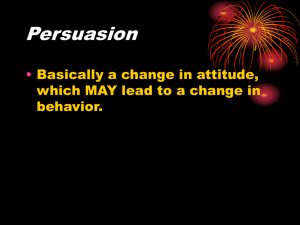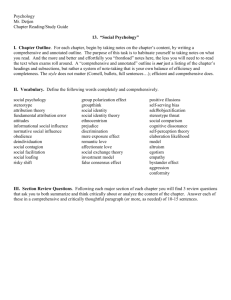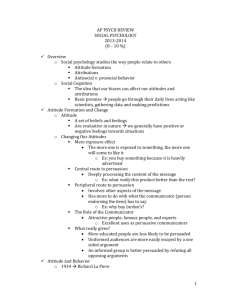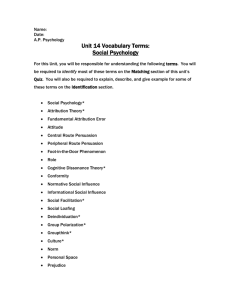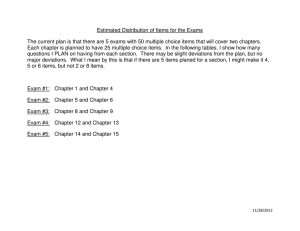Social Psychology Chapter 16
advertisement
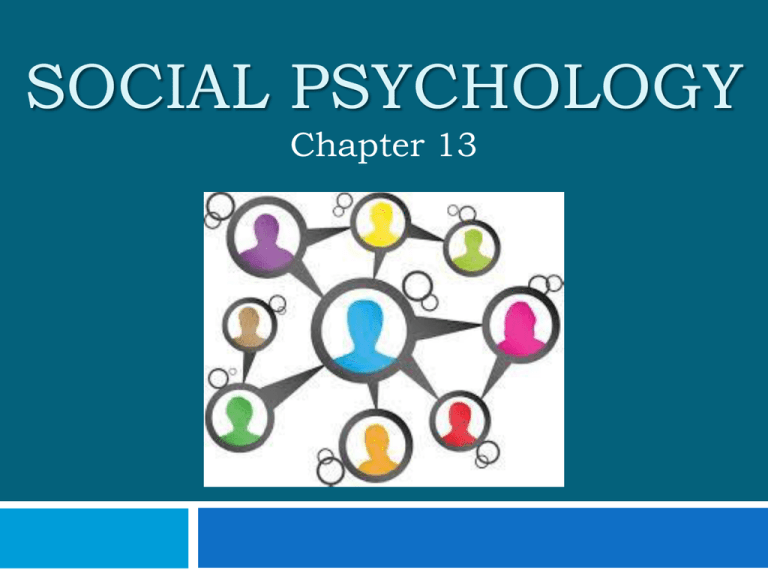
SOCIAL PSYCHOLOGY Chapter 13 SOCIAL PSYCHOLOGY Social psychology: The scientific study of how people think about, influence, and relate to one another. Social Cognition Social Behavior Social Influence Intergroup Relations Close Relationships SOCIAL COGNITION The area of social psychology that explores how people select, interpret, remember, and use social information. Essentially, it is the way in which individuals think in social situations. SOCIAL COGNITION Person Perception Physical attractiveness First impressions Attribution Attributional errors Heuristics in social information processing The Self as a Social Object Self-objectification: The tendency to see oneself primarily as an object in the eyes of others. Stereotype threat Social comparison Attitudes Attitudes can predict behavior Behavior can predict attitudes Persuasion PHYSICAL ATTRACTIVENESS “Beautiful is good” (halo effect) Averageness Symmetry Youthfulness HALO EFFECT A cognitive bias in which our overall impression of a person influences how we feel and think about their character. In the work place: A bias, common in performance ratings, that occurs when a rater gives a person the same rating on all of the items being evaluated, even though the individual varies across the dimensions being assessed. SELF-FULFILLING PROPHECY When expectations cause individuals to act in ways that serve to make the expectations come true. Shows the power of stereotypes and other expectations Robert Rosenthal and Lenore Jacobsen Pygmalion Effect (1968) FIRST IMPRESSIONS Quick Lasting Primacy effect ATTRIBUTION The process by which we come to understand the causes of others’ behavior and form an impression of them as individuals. ATTRIBUTION THEORY The view that people are motivated to discover the underlying causes of behavior as part of their effort to make sense of the behavior. Internal vs. external causes Disposition vs. situation Personal vs. environmental Stable vs. unstable causes Controllable vs. uncontrollable causes FUNDAMENTAL ATTRIBUTION ERROR Observers' overestimation of the importance of internal traits and underestimation of the importance of external situations when they seek explanations of an actor's behavior. Actor Observer Individualistic vs. Collectivistic FALSE CONSENSUS EFFECT Observers' overestimation of the degree to which everybody else thinks or acts the way they do. SPOTLIGHT EFFECT People’s tendency to assume that the social spotlight (attention) shines more brightly on them than it actually does. Barry Manilow T-shirt Experiment (2000) SELF-SERVING BIAS The tendency to take credit for our successes and to deny responsibility for our failures. Individualistic vs. Collectivistic STEREOTYPE A generalization about a group's characteristics that does not consider any variations from one individual to another. Social schemas STEREOTYPE THREAT An individual's fast-acting, selffulfilling fear of being judged based on a negative stereotype about his or her group. Based on stereotypical expectations Claude Steele and Eliot Aronson (1995) SOCIAL COMPARISON The process by which individuals evaluate their thoughts, feelings, behaviors, and abilities in relation to other people. Leon Festinger (1954) ATTITUDES AND BEHAVIORS Attitude Behavior Our Everything feelings, opinions, and beliefs about people, objects, and ideas. Internal people do that can be directly observed. Actions External WHEN ATTITUDES INFLUENCE BEHAVIOR Strong attitudes Strong awareness of attitudes & rehearses and practices attitudes Vested interest HOW BEHAVIOR INFLUENCES ATTITUDES Cognitive Dissonance Self-perception Theory An States individual's psychological discomfort caused by two inconsistent thoughts. Leon Festinger and J. Merrill Carlsmith (1957) that individuals make inferences about their attitudes by perceiving their behavior. Daryl Bem (1967) ELEMENTS OF PERSUASION Persuasion: Trying to change someone’s attitude (and behavior). The Source- communicator The Medium- method The Target- audience The Message ELABORATION LIKELIHOOD MODEL (PERSUASION) Central Route Peripheral Route Works Involves by engaging someone thoughtfully with a sound, logical argument. Facts High elaboration More durable change nonmessage factors such as the source’s credibility, attractiveness or emotional appeals. Low elaboration Less durable change PERSUASION TECHNIQUES Foot-in-the-door Door-in-the-face Strategy Strategy involves making a smaller request at the beginning, and then making the biggest request last (after the small request has been accepted). involves making the biggest request at the beginning, and then making a smaller “concessionary” request last (after the big request has been rejected).

